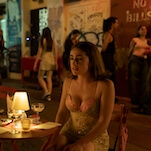Every critic develops ideological convictions, consciously or unconsciously. I have at least three significant beliefs that pop up again and again in my reviews—so frequently, in fact, that not literally repeating myself becomes a real challenge. One of them pertains specifically to documentaries: I have little patience for docs that are merely expository, presenting a superficially glossy précis of information that could be (and often has been) explored just as well, and much more thoroughly, in a book or a lengthy article. Another involves literary adaptations, the vast majority of which fail, it seems to me, because the source material’s greatness is rooted in elements—prose style, interior monologue—that don’t translate well to the screen. My most notorious conviction, though, is that editing is the essence of cinema, and that efforts to avoid cutting while moving the camera all over the place are fundamentally misguided. I’ve tried making that case in detail twice, and both times it provoked a firestorm of enraged comments. All the same, I still believe it, and the essence of the argument is fairly simple: Don’t show off unless there’s a good reason to show off.
What constitutes a good reason? So glad you asked. I devoted a previous column to the justly revered opening shot of Orson Welles’ Touch Of Evil—partly because it was an obvious choice, but also partly as a way of demonstrating that I don’t automatically hate virtuoso single-shot stunts. Celebrating a classic isn’t exactly daring, though, so let’s try this again with a more recent, less bulletproof example: the gloriously over-the-top opening credit sequence of JCVD (2008), starring Jean-Claude Van Damme as “himself.” The film’s meta-heavy premise finds Van Damme, with his career as an action star on the wane, stumbling into a real-life bank robbery and being mistaken for one of the robbers; it’s a cheeky meditation on celebrity, in which Van Damme at one point delivers a brutally frank, direct-to-camera monologue laying out his inner demons. But director and co-writer Mabrouk El Mechri first has to establish that Van Damme isn’t who he used to be, and he does so via precisely the sort of elaborate, look-ma-no-cuts tour de force that usually annoys me. Basically, it’s a gleeful parody of what I hate, which is why I love it. Here, take a look:
The very first joke here—a riff on what was then the Gaumont logo (it was changed in 2011), with an animated Van Damme kicking the shit out of its flower-clutching little boy—sets the goofy tone. Gaumont’s sappy theme music gives way to Baby Huey’s hard-driving “Hard Times,” ensuring that nobody will take the ensuing onslaught of violence seriously; not only is the tune (written by Curtis Mayfield) upbeat, but its lyrics are hilariously on-the-nose, underlining just how much work this is for Van Damme. He’s having hard times in this crazy town! Times are so hard, in fact, that this movie apparently can’t be bothered with anything so mundane as establishing a character or a narrative—Van Damme just shows up in a context-free nightmare world and starts laying waste to everyone in sight. This will eventually be revealed as a film-within-the-film (i.e., this scene probably occurs somewhere in the middle of the fake movie for which it’s being shot), but a first-time viewer of JCVD doesn’t yet know that. There’s a giddiness to being thrown into an action sequence like this with no prelude whatsoever, and that’s compounded as the sequence goes on and on and on without a visible cut. It starts out ludicrous and gets more ludicrous.
Then the glitches become apparent. For the most part, El Mechri maintains the pretense that this is a “normal” action flick, choreographing the scene as one typically would; bullets ricochet when and where they’re supposed to, for example, which requires some skill. Early on, though, Van Damme engages in a quick fistfight, and his knockout punch clearly doesn’t connect. You could practically insert a loaf of bread between his fist and the goon’s face at the alleged moment of impact. Lengthwise. That’s the first clue that everything isn’t as it seems, though viewers unfamiliar with JCVD’s premise (and familiar with Occam’s razor) are likely to assume ineptitude. Other mistakes follow—“the window didn’t explode right,” Van Damme complains to the director, apparently in reference to the moment in which he shoves someone’s head through a car window that doesn’t seem to exist (though we hear it break). And even bits that aren’t mistakes, like the dude who backs into a jeep that’s been shot with a flamethrower and catches fire himself, feel like such overkill that you have to laugh. The sequence as a whole comes across more like some aspiring filmmaker’s desperate demo reel than like something that might appear in an actual movie.
As it happens, that perfectly describes what bugs me about most shots like this one. I’ve long argued—and this is where some of you strenuously disagree with me, which is your right (but you’re wrong)—that these shots derive much of their tension from the viewer’s conscious or unconscious awareness of how much painstaking effort and careful planning goes into them, and of how easily they could be ruined by just one little thing going wrong. While that can be exhilarating in the right context, it’s more often a distraction, at least for me. The exceptions occur when there’s an explicit time element (as in Touch Of Evil), or when the naked desire to impress gets explicitly foregrounded. Here, the pointless extravagance is itself the point, building to a punchline in which an extra slams the door so hard that the fake wall falls to the ground, negating all the preceding effort. Had the sequence been assembled in the traditional way, using multiple camera setups, no big deal—just shoot the last part again. But that’s not an option in this case, even if the dart-throwing, Hollywood-hating director seems weirdly indifferent to the problem.
Furthermore, shooting this sequence without cuts works beautifully because Jean-Claude Van Damme was 47 years old. “It’s very difficult for me to do everything in one shot,” he admits, though he has to keep pausing because he’s so out of breath; notably, he disappears from the shot for a good 20 seconds at one point (during which time it’s hard to even discern who we’re supposed to be rooting for, given the utter lack of context—other people are fighting, but we have no idea who’s on Van Damme’s side). My favorite touch is El Mechri’s choice to superimpose the film’s title over the few seconds during which Van Damme plays dead, which can be seen as a mockingly self-deprecating allusion to his career. But the general relentlessness of the single take simultaneously emphasizes the character’s superhuman abilities and exposes the actor’s fragility. It has a clear purpose that transcends “Hey, look what I can do!” And that’s all I ask. Executing a shot that demands split-second timing sustained over several minutes, thereby calling attention to itself, is an enormous undertaking. Ego alone isn’t sufficient reason. Find something more.








































